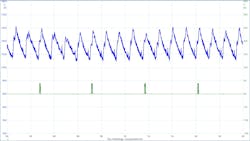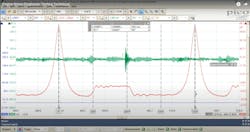I’ll be the first to tell you that being a technician under pressure to get the job done quickly is not a stress-free position. This intensity is multiplied tenfold when you factor in the flat-rate pay scale for a technician (a concept I disagree with wholeheartedly).
With that, many will jump at the opportunity to draw a diagnosis from a single piece of data that coorelates with an exhibited symptom. However, I urge you to step back and revisit the vehicle from a different angle.
Stepping Stones
As I've mentioned many times before in previous articles, I always choose to take the diagnostic path that yields me the most information for the least amount of time or energy invested. I joke about this as my being inherently lazy. But the truth is it’s just more logical and efficient to conduct testing in this manner. After all, we don’t necessarily do this job as a hobby. I mean, we may love it (heck, I think you must love it to be any good at it) but we do it to be profitable. Although profitability likely interests everyone, it’s the increase in accuracy that this logical approach to testing brings to the table that motivates me. The profitability follows naturally.
This is best discussed by way of example. Assume a vehicle was towed into the shop with a dead battery. Some may choose to conduct a capacitance test with the devices we typically implement at a multi-point service check (Figure 1). A failure would be a reason for most technicians to replace the battery. I agree with that approach, but we can’t stop there. There are still a few unanswered questions that must be pursued. The goal? To not fix the symptom but to fix the root cause of that symptom. In plain English, what caused the dead battery? Below are just a few questions that come to mind:
- Is the battery just old and expired?
- Is there a parasitic drain present, killing the battery?
- Is the alternator charging properly?
- If not, why? Is there a voltage drop elsewhere in the battery charging circuit?
Eliminating those above possibilities in logical order would mean beginning with the easiest test and concluding with the most difficult or most time-consuming test. That is, of course, if the customer approves the diagnostic time.
Although this is just a quick example of what I'm trying to portray, let's follow through with an actual case study. You’ll see, had the tech not pursued the root cause of the issue, a lot of money and heartache would’ve been invested.
Initial Approach
A vehicle was brought into the workshop with the complaint of “MIL illuminated.” Upon retrieving the vehicle and preliminary evaluation with the scan tool, the technician discovered a DTC, P0304-cylinder No. 4 misfire was set in history (Figure 2).
A road test of the vehicle was conducted, and the engine was run throughout the entire operating range. The technician did note some slight misfire/driveability concerns exhibited mostly during idle conditions. Considering she is still in the driver’s seat, the tech thought it best to monitor the fuel trim activity as it is a clear reflection of combustion quality or lack thereof, as well as an indicator of what type of misfire may be exhibited (like an ignition fault, an injection fault, or an engine mechanical fault) (Figure 3).
The misfire was felt at the time the fuel trim was monitored and the lack of compensation allowed the technician to determine the fault was unlikely to be from the ignition system or the fueling system. This put an engine mechanical concern at the top of the list of suspected root-cause faults. Again, all from the driver’s seat.
The PCM’s misfire data was then monitored to determine if cylinder No. 4 may be the cylinder responsible for the driveability fault (Figure 4). The data PIDs concur that cylinder No. 4 is registering misfires. Although misfire detection software is much more reliable than in years past, it is not foolproof. Misfire data is just another piece of the diagnostic puzzle.
A relative compression test was conducted, and the results did not reflect a significant loss of compression (Figure 5). Although this seems contradictory to an engine mechanical fault diagnosis, we must keep in mind that a loss in compression isn’t always the result of an engine mechanical fault. The relative compression test is limited to only indicating if and how well the cylinder can harness and squeeze its contents.
Generalized Testing
As the technician eventually made her way beneath the hood to continue her diagnostic path, she noted an alarming, rhythmic noise resonating from within the engine compartment. This raised a few questions:
- Could the noise be from cylinder No. 4?
- Could the noise be related to the misfire?
- Could the noise be a different problem altogether?
- How can we determine where the noise originates from?
The above questions are indeed very logical, and I urge you as diagnosticians to consistently question yourself as you proceed through an analysis. The questions you ask should determine the tests you follow up with. The test results should answer the questions.
Implementing the mechanic’s stethoscope will allow her to pinpoint the noise with relative ease and help her decide how to proceed (Figure 6). Again, the takeaway is the test being performed is a bit more involved than just sitting in the driver’s seat with the scan tool, but it was justified as time well spent and it will definitely bring her closer to a conclusive diagnosis.
The engine noise was analyzed with the stethoscope from beneath the hood and the noise was loudest at the cylinder head area of cylinder No. 4. This answers one of the above questions. However, it doesn’t necessarily indicate if the noise is from the valve train or the piston and rod assembly of cylinder No. 4.
The tech then chose to implement a pulse sensor and oscilloscope. The same stethoscope was used to locate the noise, however, instead of pumping information into the tech’s ear, the stethoscope was connected to the pulse sensor. The intensity of the generated pulse signal will correlate with the noise occurrence and location. The pulse was not only visible but indicated the noise occurred twice per engine cycle (Figure 7). This puts a valve train noise at the bottom of the list of root causes since the camshaft turns once per engine cycle.
The vehicle was hoisted to allow access to the bottom-end area and noise was obvious in this area of cylinder No. 4 as well, and equally as intense. The results of this test corroborate the noise is not likely to be in the valve train but internal to the engine block.
Pinpointed Testing
Considering the questions above, if we could temporarily eliminate the cause of the misfire, we could find an answer to all of them simultaneously. Considering this vehicle’s configuration, access to the COP ignition coils is easily obtained (Figure 8).
As the engine idled and the noise was exhibited, the COP of the suspect cylinder No. 4 was disabled. By unplugging the coil, a consistent misfire would definitely occur, but the bigger takeaway is since no combustion is taking place, the noise also vanished. What’s the point? The noise is not likely to be between the crankshaft journal and the main bearing cap. Meaning, that the noise is likely between the No. 4 piston and wrist pin or the connecting rod bearing and crankshaft journal. The cost of repair will vary depending on which fault is present. All the questions above can be answered if we take the analysis just a little bit further. With that another set of questions comes to mind:
- Can we determine the engine-mechanical fault without disassembly?
- What test result may help draw that conclusion?
Some logical thinking is required to answer these questions but there is a test that may help put the final nail in the coffin and deliver a diagnosis we can be confident in speaking about with the customer. Because low-end engine noise is present, we do have to consider the collateral damage that may be taking place. Again, the idea is to give the customer the most accurate diagnosis possible so he or she can make a sound decision about whether the repair of this fault is right for them financially.
Keeping the trend of analysis without disassembly is the theme of this article. By placing that same pulse sensor on the dipstick tube, the tech obtained data that accurately depicts the conditions within the crankcase of the engine. She cranked the engine over several cycles and a pattern was noticed. The pattern indicated an increase in crankcase pressure once per engine cycle.
With some research of the firing order and adding an ignition sync on a second channel of the scope, the tech was able to correlate the rise in crankcase pressure with the top-dead-center (TDC) of cylinder No. 4, our suspect cylinder (Figure 9). This is an indicator that the surface between the piston assembly and the cylinder walls has been compromised. This one piece of data prevented the attempt at repair that could have been a lot of money and time invested without even addressing the collateral damage created by the engine noise we would be attempting to rectify. This would certainly be a bad day for the technician, the shop, and the customer.
This final piece of data allows her to approach her service advisor and alert the customer of the bad news — or is it really good news? Regardless of whether the engine mechanical fault is contributing to the misfire, the cost of repair makes engine replacement the only logical option. This customer must decide whether to get rid of the vehicle or invest in the replacement of the engine.
The takeaway from this case study is that all of this was obtained from data that is easily accessible, takes minutes to obtain, and requires no disassembly whatsoever. The technician got paid handsomely for honest testing that gave the customer a pinpoint engine-internal fault diagnosis without the associated cost of traditional disassembly/inspection. Although that would be the next step, the customer is aware and will be able to anticipate what is to be found upon disassembly and inspection, and that is worth something.
The next time you face making a tough call about something as expensive as an internal engine mechanical failure, don’t panic, and don’t guess. Implement multiple tests in a logical succession and you will find yourself placing multiple arrows in the same target. This will increase your level of accuracy many times over, decrease your applied diagnostic time by minimizing disassembly, and establish confidence in you that makes your job as a diagnostician very rewarding. That's something we should all be proud of.
Tools used
- Capacitance tester
- Scan Tool
- Mechanic's stethoscope
- Pulse sensor
- Oscilloscope
- Amp probe
About the Author
Brandon Steckler
Technical Editor | Motor Age
Brandon began his career in Northampton County Community College in Bethlehem, Pennsylvania, where he was a student of GM’s Automotive Service Educational program. In 2001, he graduated top of his class and earned the GM Leadership award for his efforts. He later began working as a technician at a Saturn dealership in Reading, Pennsylvania, where he quickly attained Master Technician status. He later transitioned to working with Hondas, where he aggressively worked to attain another Master Technician status.
Always having a passion for a full understanding of system/component functionality, he rapidly earned a reputation for deciphering strange failures at an efficient pace and became known as an information specialist among the staff and peers at the dealership. In search of new challenges, he transitioned away from the dealership and to the independent world, where he specialized in diagnostics and driveability.
Today, he is an instructor with both Carquest Technical Institute and Worldpac Training Institute. Along with beta testing for Automotive Test Solutions, he develops curriculum/submits case studies for educational purposes. Through Steckler Automotive Technical Services, LLC., Brandon also provides telephone and live technical support, as well as private training, for technicians all across the world.
Brandon holds ASE certifications A1-A9 as well as C1 (Service Consultant). He is certified as an Advanced Level Specialist in L1 (Advanced Engine Performance), L2 (Advanced Diesel Engine Performance), L3 (Hybrid/EV Specialist), L4 (ADAS) and xEV-Level 2 (Technician electrical safety).
He contributes weekly to Facebook automotive chat groups, has authored several books and classes, and truly enjoys traveling across the globe to help other technicians attain a level of understanding that will serve them well throughout their careers.









